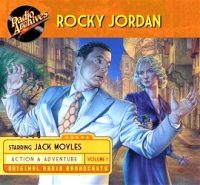
 Rocky Jordan (1948-1950) aired “The Gum Queen” on August 21, 1949. This is the 13th Rocky Jordan episode we have showcased since 2011 and the first in over a year. Borrowed from a previous introduction for the benefit of new listeners unfamiliar with the Rocky Jordan program, here are the basics of the show’s background. Rocky Jordan ran from October 21, 1948 through September 5, 1950 and starred Jack Moyles as Rocky Jordan. There were several iterations of the show, the first of which aired in 1945 under the title A Man Named Jordan. Only two episodes of this early precursor are known to still exist. This version was set in Istanbul, Turkey but was otherwise the same as its successor. An attempt to revive the series with famed Hollywood actor George Raft aired for one season from 1950-51. A couple of half-hearted attempts were made at further revivals in 1955 and ’57, but none of these fifteen-minute episodes survives.
Rocky Jordan (1948-1950) aired “The Gum Queen” on August 21, 1949. This is the 13th Rocky Jordan episode we have showcased since 2011 and the first in over a year. Borrowed from a previous introduction for the benefit of new listeners unfamiliar with the Rocky Jordan program, here are the basics of the show’s background. Rocky Jordan ran from October 21, 1948 through September 5, 1950 and starred Jack Moyles as Rocky Jordan. There were several iterations of the show, the first of which aired in 1945 under the title A Man Named Jordan. Only two episodes of this early precursor are known to still exist. This version was set in Istanbul, Turkey but was otherwise the same as its successor. An attempt to revive the series with famed Hollywood actor George Raft aired for one season from 1950-51. A couple of half-hearted attempts were made at further revivals in 1955 and ’57, but none of these fifteen-minute episodes survives.
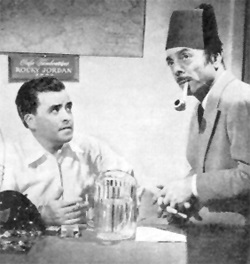 Rocky Jordan was modeled on the classic, much revered movie Casablanca, which premiered in New York on November 26, 1942 and then in general release on January 23, 1943. Casablanca starred Humphrey Bogart as Rick Blaine, the American exile who ran Rick’s Cafe Americain in Casablanca, Morocco, an unallied country during World War II located in northwest Africa and bordering the Mediterranean Sea. Rocky Jordan is set in Cairo, Egypt, in northeast Africa, said country also bordering the Mediterranean. Rocky calls St. Louis home (but was chased abroad by his enemies), whereas Rick hailed from New York; both are intimated to have shady pasts. The counterpart to Rick’s Cafe Americain is Rocky Jordan’s Cafe Tambourine, not far from the “mosque Sultan Hassan,” (photo below) where Rocky finds himself routinely involved with “crime, mystery, and beautiful women.” Much like Rick’s Cafe Americain which is set during WW II, Jordan’s Cafe Tambourine, while set a few short years following the war, is a magnet for all ethnicities and types, from the respectable to the rogue.
Rocky Jordan was modeled on the classic, much revered movie Casablanca, which premiered in New York on November 26, 1942 and then in general release on January 23, 1943. Casablanca starred Humphrey Bogart as Rick Blaine, the American exile who ran Rick’s Cafe Americain in Casablanca, Morocco, an unallied country during World War II located in northwest Africa and bordering the Mediterranean Sea. Rocky Jordan is set in Cairo, Egypt, in northeast Africa, said country also bordering the Mediterranean. Rocky calls St. Louis home (but was chased abroad by his enemies), whereas Rick hailed from New York; both are intimated to have shady pasts. The counterpart to Rick’s Cafe Americain is Rocky Jordan’s Cafe Tambourine, not far from the “mosque Sultan Hassan,” (photo below) where Rocky finds himself routinely involved with “crime, mystery, and beautiful women.” Much like Rick’s Cafe Americain which is set during WW II, Jordan’s Cafe Tambourine, while set a few short years following the war, is a magnet for all ethnicities and types, from the respectable to the rogue.
 As you might imagine, Rocky seems always to find himself at the center of trouble. Egyptian-Muslim police Captain Sam Sabaaya (married with four children) plays it straight and by the book but helps Rocky when he can, while Sabaaya’s Sergeant Greco dislikes Jordan and attempts to pin every mishap and crime on the part-time detective and foreigner.
As you might imagine, Rocky seems always to find himself at the center of trouble. Egyptian-Muslim police Captain Sam Sabaaya (married with four children) plays it straight and by the book but helps Rocky when he can, while Sabaaya’s Sergeant Greco dislikes Jordan and attempts to pin every mishap and crime on the part-time detective and foreigner.
The writers always strove for authenticity in Rocky’s adventures, researching names of streets and places for accuracy, and the show’s producers even hired an Egyptian writer/consultant in later episodes for further accuracy of detail in regard to the locales and various cultures, Cairo being a centuries-long crossroads and melting pot of the Middle East.
This episode opens as many of them seem to, in Rocky’s Cafe Tambourine, where Rocky is approached and asked if it would be possible to schedule the entire cafe for a certain traveler and her caravan for a party. Not averse to such a relatively common request, Rocky needs further specific details before a firm commitment on his part can be made. One such detail is that Rocky speak to the head of the caravan herself, the woman who is transporting a year’s worth of gum arabic (a common product) via a 24-camel caravan to its point of sale and final destination, and that Rocky travel to a specific location in the desert to meet with this woman to finalize the agreement. Of course, the meeting does not go as planned and violent misfortune ensues, the nature of which will be revealed during the listening of this episode. What can be revealed is that Rocky and police Captain Sam Sabaaya become involved in the curious affair and must discover the who and why of it all, the why being of course the more important of the two unanswered questions, it being the motive, the reason for the surprise attack on an innocent caravan of gum arabic in the first place. The answer may or may not surprise you, though it is as old as the timeless sands of ancient Egypt, sands that have known the footsteps of men and women both good and evil, famous and infamous, of humble character and prideful ego, men and women who would give of themselves to help others and those who would steal from others to help themselves. Listen now to the story of “The Gum Queen” to learn which kind you find here.
(The CD linked at the top of the page includes “The Gum Queen.”
Play Time: 29:58
{With their summer vacation quickly coming to a close, the neighborhood gang met once again at their favorite home away from home, the corner newsstand, still hungering for more tales of adventure like the one they had heard the night before on Rocky Jordan. Danger and intrigue being the order of the day, they were in luck. Black Mask (1920-51) wore the crown as the finest detective pulp magazine of them all, and justly so given the now classic stories it ran between its pages (one of which was Dashiell Hammett’s The Maltese Falcon, serialized beginning with the September 1929 issue). It was a bi-monthly in 1949. Crack Detective Stories (1938-57) would suffer a number of name changes during its history, but was known by the name you see here from May 1942 until its final issue under the Crack title in September 1949 (the issue shown below), when it would become Famous Detective for a few months before becoming Famous Detective Stories for almost 6 years. It would end its run in July of 1957 as Crack Detective and Mystery Stories. In 1949 Crack Detective Stories was bi-monthly. Ten Story Detective (1938-49) found its niche with a more traditional approach, focusing on action-oriented police stories, which certainly had its place in the pantheon of crime/detective pulps. It was a bi-monthly in 1949 and the issue below happened to be its last.}
[Left: Black Mask, 9/49 – Center: Crack Detective, 9/49 – Right: Ten Story Detective, 8/49]
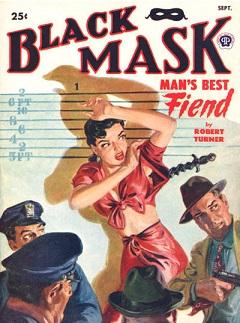
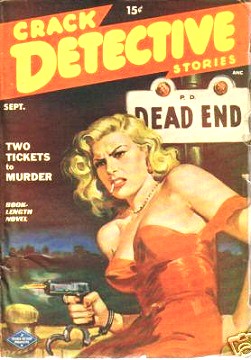
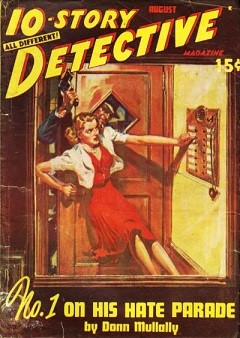
To view the entire list of Old Time Radio episodes go here.